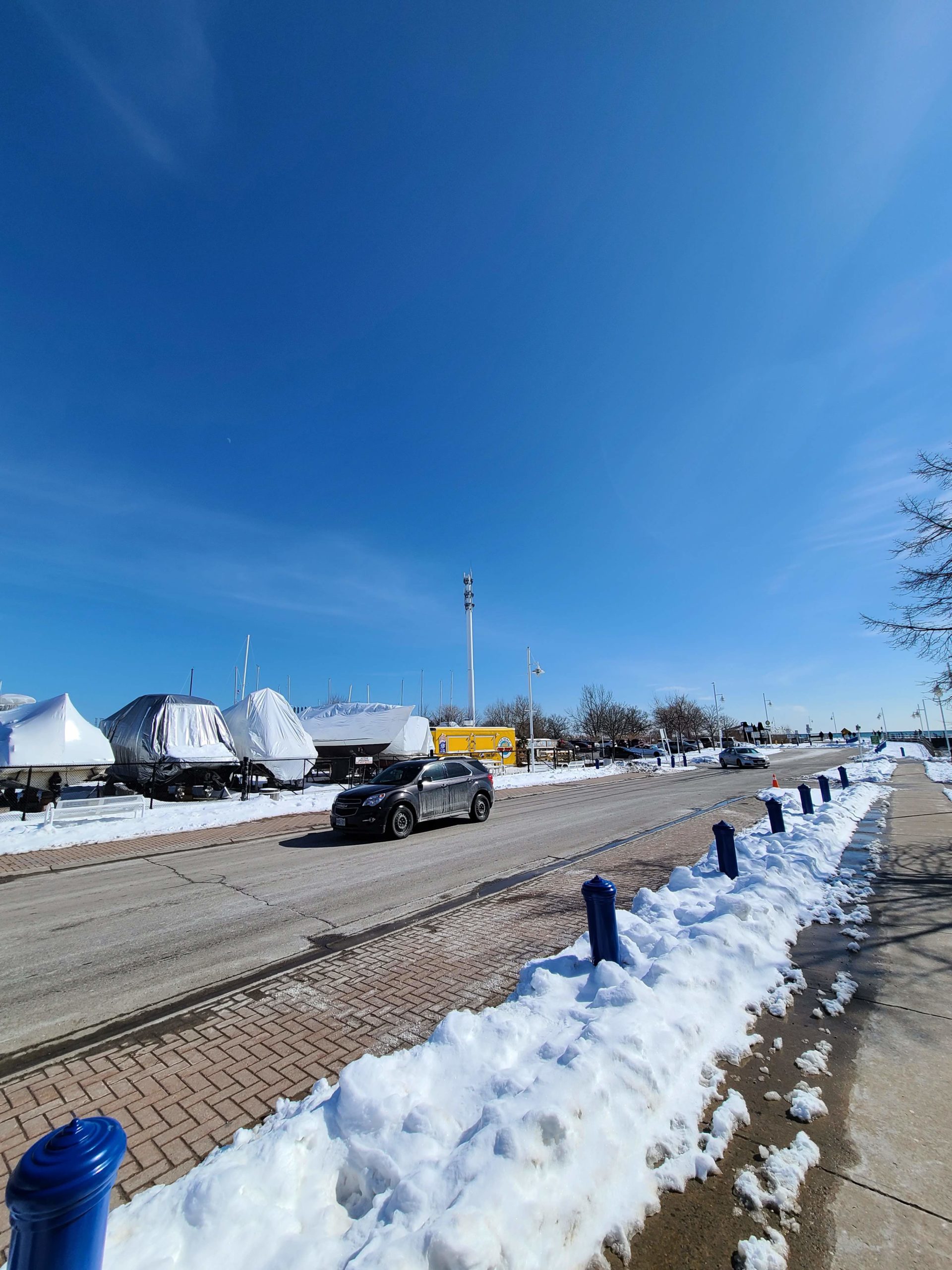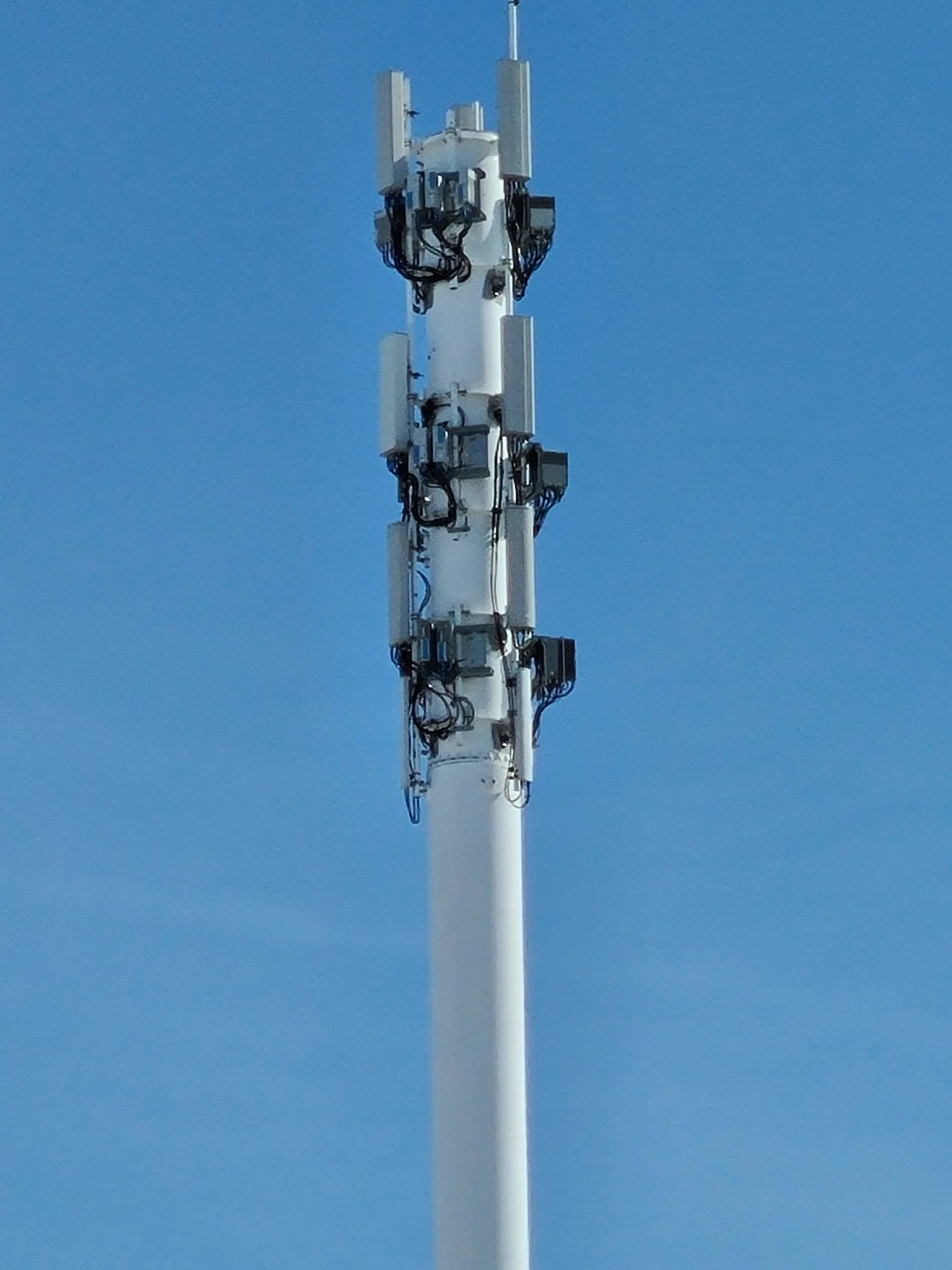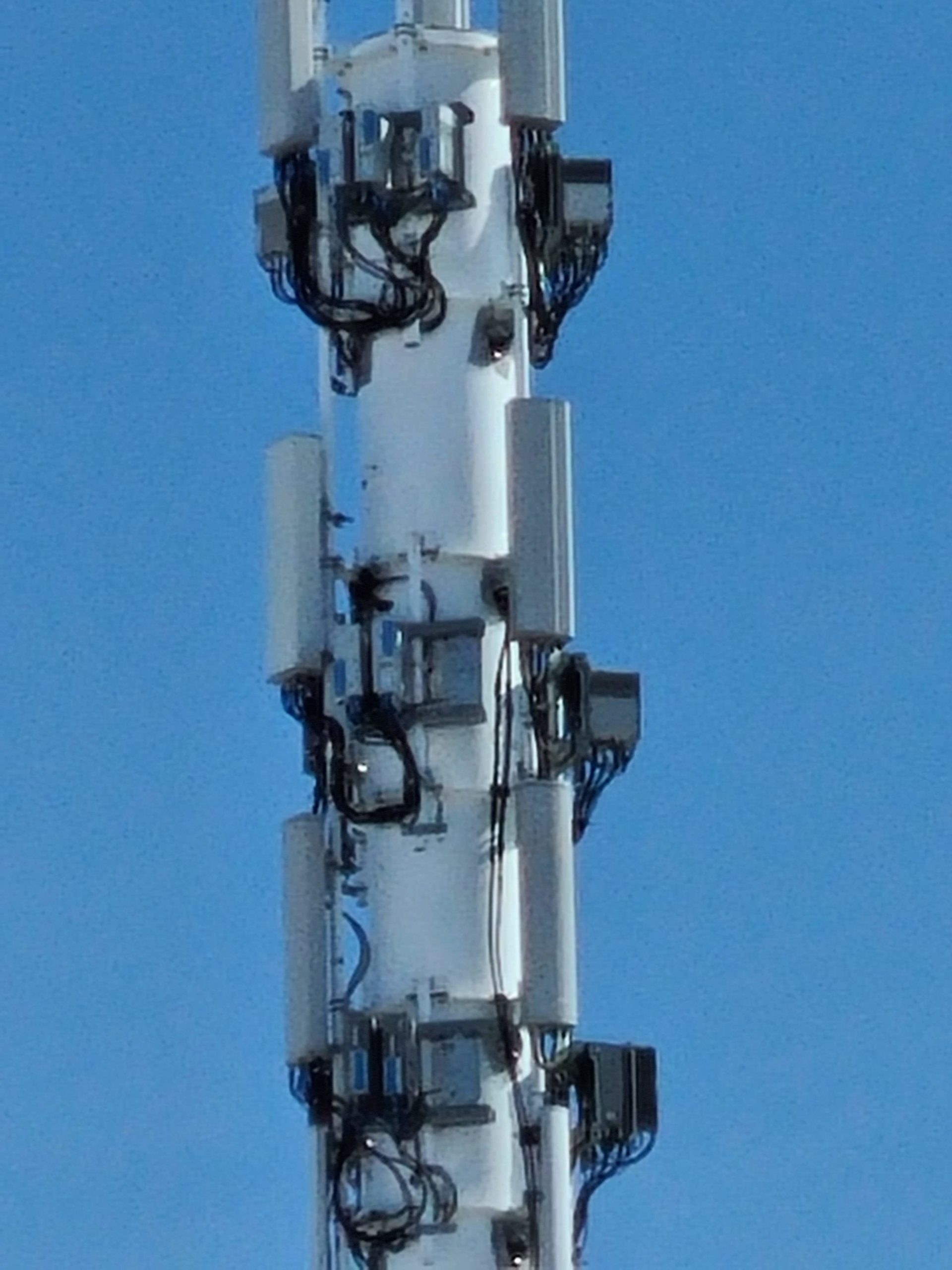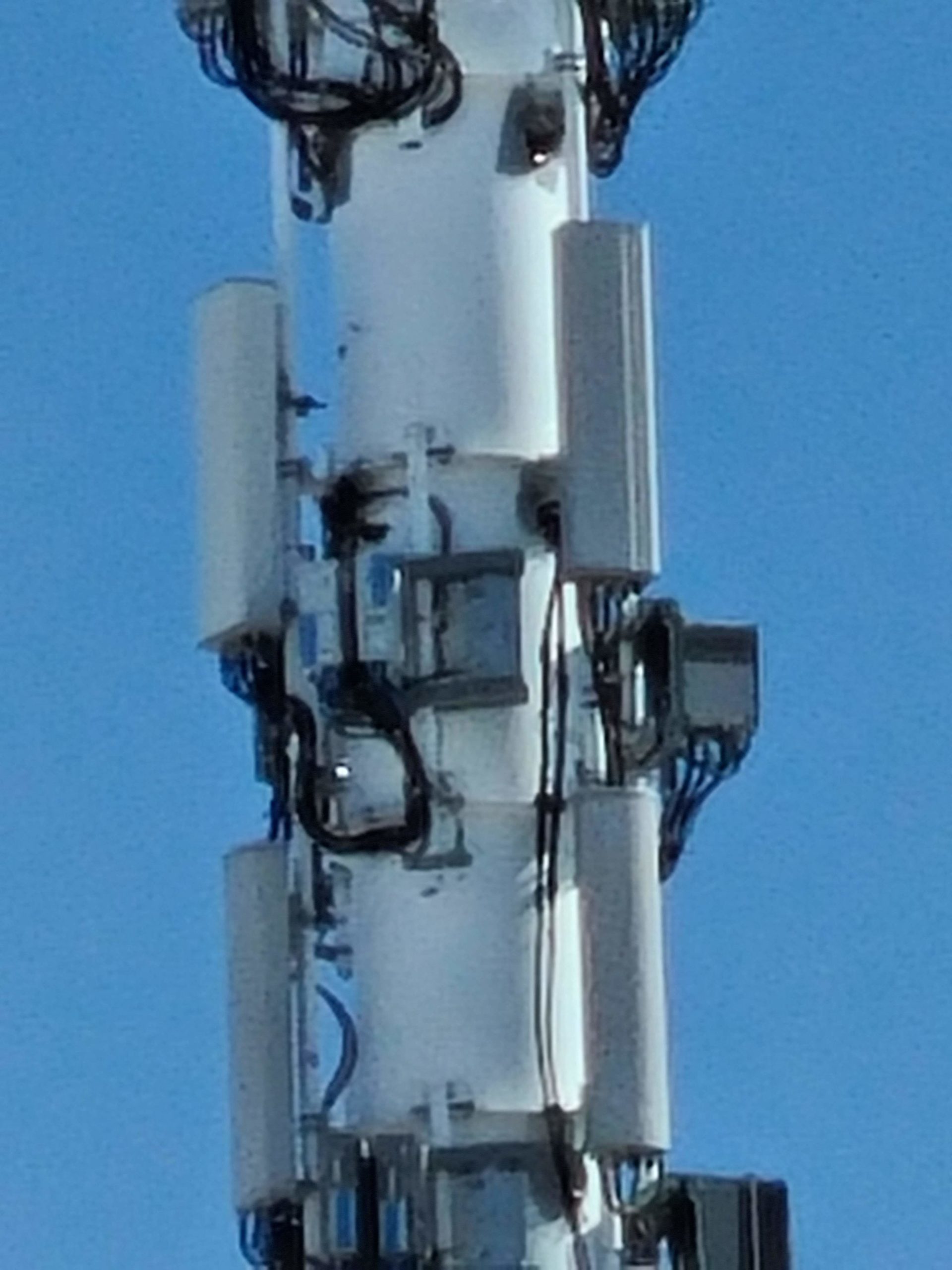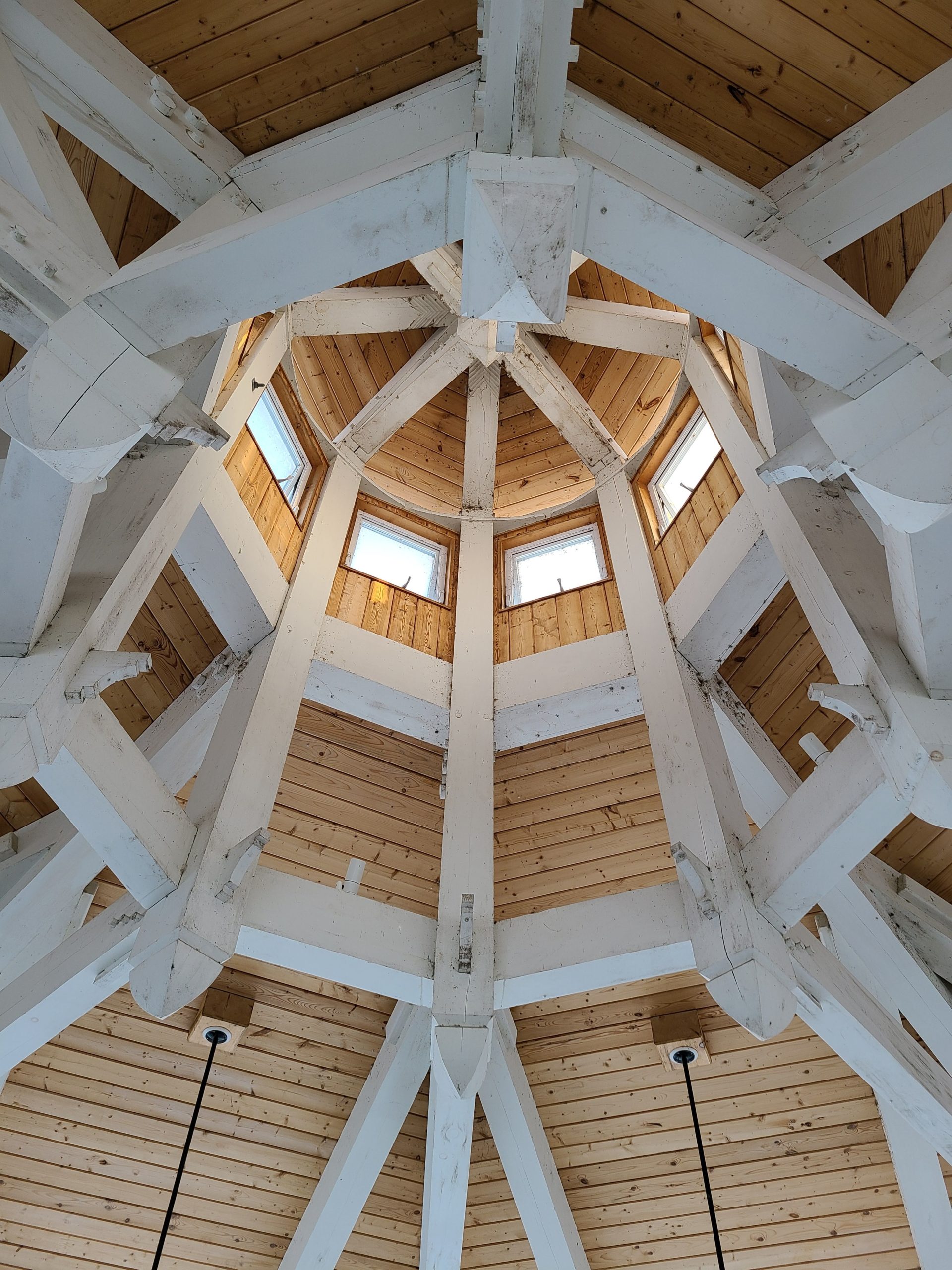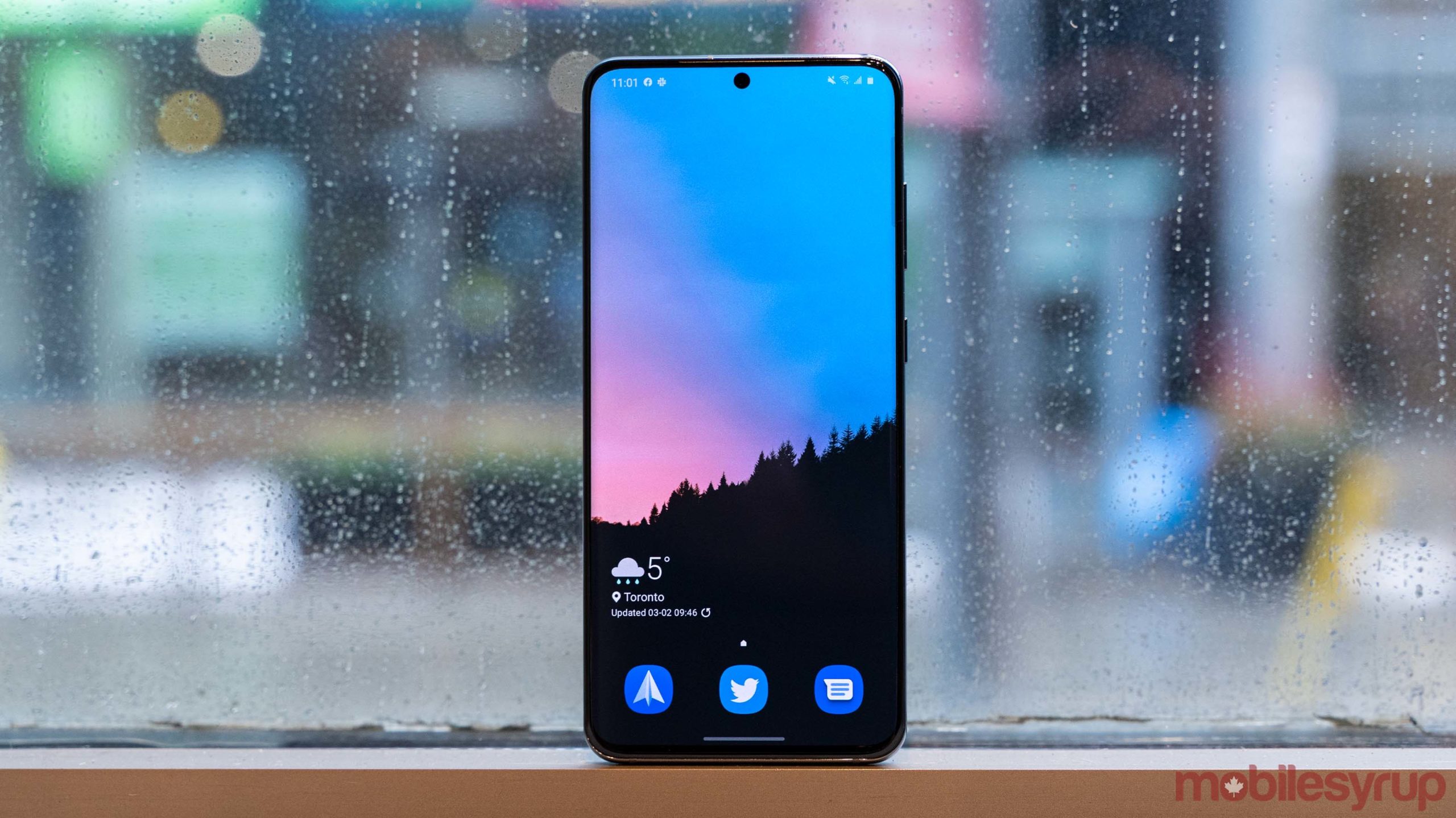
The Pros
- Perfect size
- Excellent display
- Great battery life
The Cons
- Best features aren't in Canada
- Fingerprint scanner is hit and miss
- One UI can be confusing
It was with deep sadness that I waved farewell to last year’s excellent Galaxy S10e. In many ways, I’d argue that it was the best Galaxy flagship on offer from Samsung, boasting most of the critical improvements without excesses like massive displays and curved edges. It truly was a smartphone for the average person.
While Samsung chose not to bring the ‘e’ model forward into 2020, it did, in a sense, replace it.
This year, the South Korean company launched three flagship Galaxy S smartphones. However, instead of a lesser ‘e’ version, the company opted for a more impressive ‘Ultra’ variant with its new Galaxy S20 line. Along with the S20 Ultra, we also got the S20+ and the S20. Samsung provided us with one of each for review, and I opted for the S20 since it is the spiritual successor to last year’s S10e.
However, the S20 is not an ‘e’ device by any stretch. It’s more expensive than the S10e by about $300 in Canada, it has a bigger screen and a fully-fledged camera system. Instead, the S20 succeeds the S10e by taking its place as the cheapest of the three new Samsung flagships, although to call the S20 ‘cheap’ is a longshot.
That’s not to say that the S20 is inferior to the other devices. On the contrary, the S20 is the one you probably should buy of the three. It’s big without being too big, feature-rich without being overloaded and generally an excellent value compared to the other phones in the lineup.
If you’re looking for the Galaxy S20+ review, you can find it here. Or, if you’re looking for the S20 Ultra review, you can find it here.
Samsung Galaxy S20
Samsung Galaxy S20+
Samsung Galaxy S20 Ultra
Display
6.2-inch Curved Dynamic AMOLED, 3,200 x 1,440 pixels, 20:9 aspect ratio, 120Hz display
6.7-inch Curved Dynamic AMOLED, 3,200 x 1,440 pixels, 20:9 aspect ratio, 120Hz display
6.9-inch Curved Dynamic AMOLED, 3,200 x 1,440 pixels, 20:9 aspect ratio, 120Hz display
Processor
Snapdragon 865
Snapdragon 865
Snapdragon 865
RAM
12GB of RAM
12GB of RAM
12GB of RAM, 16GB of RAM
Storage
128GB
128GB, 512GB
128GB, 512GB
Dimensions (in.)
152 x 68 x 7.9mm
162 x 74 x 7.8mm
167 x 76 x 8.8mm
Weight
164g
188g
221g
Rear Facing Camera
12.2-megapixel (wide) + 64-megapixel (telephoto) + 12-megapixel (ultra-wide angle)
12.2-megapixel (wide) + 64-megapixel (telephoto) + 12-megapixel (ultra-wide angle)+ TOF depth sensor
108-megapixel (wide) + 48-megapixel (telephoto) + 12-megapixel (ultra-wide angle) + TOF depth sensor
Front Facing Camera
10-megapixel
10-megapixel
40-megapixel
OS
Android 10
Android 10
Android 10
Battery
4,000mAh
4,500mAh
5,000mAh
Network Connectivity
GSM/HSPA/LTE/5G
GSM/HSPA/LTE/5G
GSM/HSPA/LTE/5G
Sensors
Fingerprint (in-display), accelerometor, gyro, proximity, compass
Fingerprint (in-display), accelerometor, gyro, proximity, compass
Fingerprint (in-display), accelerometor, gyro, proximity, compass
SIM Type
Nano SIM
Nano SIM
Nano SIM
Launch Date
March 6, 2020
March 6, 2020
March 6, 2020
Misc
Colours: Cosmic Black, Cosmic Grey, Cloud Blue | 120Hz display, 240Hz touch sample rate
Colours: Cosmic Grey, Cosmic Black, Cloud Blue | 120Hz display, 240Hz touch sample rate
Colours: Cosmic Grey, Cosmic Black | 120Hz display, 240Hz touch sample rate
Display
Samsung Galaxy S20
6.2-inch Curved Dynamic AMOLED, 3,200 x 1,440 pixels, 20:9 aspect ratio, 120Hz display
Samsung Galaxy S20+
6.7-inch Curved Dynamic AMOLED, 3,200 x 1,440 pixels, 20:9 aspect ratio, 120Hz display
Samsung Galaxy S20 Ultra
6.9-inch Curved Dynamic AMOLED, 3,200 x 1,440 pixels, 20:9 aspect ratio, 120Hz display
Processor
Samsung Galaxy S20
Snapdragon 865
Samsung Galaxy S20+
Snapdragon 865
Samsung Galaxy S20 Ultra
Snapdragon 865
RAM
Samsung Galaxy S20
12GB of RAM
Samsung Galaxy S20+
12GB of RAM
Samsung Galaxy S20 Ultra
12GB of RAM, 16GB of RAM
Storage
Samsung Galaxy S20
128GB
Samsung Galaxy S20+
128GB, 512GB
Samsung Galaxy S20 Ultra
128GB, 512GB
Dimensions (in.)
Samsung Galaxy S20
152 x 68 x 7.9mm
Samsung Galaxy S20+
162 x 74 x 7.8mm
Samsung Galaxy S20 Ultra
167 x 76 x 8.8mm
Weight
Samsung Galaxy S20
164g
Samsung Galaxy S20+
188g
Samsung Galaxy S20 Ultra
221g
Rear Facing Camera
Samsung Galaxy S20
12.2-megapixel (wide) + 64-megapixel (telephoto) + 12-megapixel (ultra-wide angle)
Samsung Galaxy S20+
12.2-megapixel (wide) + 64-megapixel (telephoto) + 12-megapixel (ultra-wide angle)+ TOF depth sensor
Samsung Galaxy S20 Ultra
108-megapixel (wide) + 48-megapixel (telephoto) + 12-megapixel (ultra-wide angle) + TOF depth sensor
Front Facing Camera
Samsung Galaxy S20
10-megapixel
Samsung Galaxy S20+
10-megapixel
Samsung Galaxy S20 Ultra
40-megapixel
OS
Samsung Galaxy S20
Android 10
Samsung Galaxy S20+
Android 10
Samsung Galaxy S20 Ultra
Android 10
Battery
Samsung Galaxy S20
4,000mAh
Samsung Galaxy S20+
4,500mAh
Samsung Galaxy S20 Ultra
5,000mAh
Network Connectivity
Samsung Galaxy S20
GSM/HSPA/LTE/5G
Samsung Galaxy S20+
GSM/HSPA/LTE/5G
Samsung Galaxy S20 Ultra
GSM/HSPA/LTE/5G
Sensors
Samsung Galaxy S20
Fingerprint (in-display), accelerometor, gyro, proximity, compass
Samsung Galaxy S20+
Fingerprint (in-display), accelerometor, gyro, proximity, compass
Samsung Galaxy S20 Ultra
Fingerprint (in-display), accelerometor, gyro, proximity, compass
SIM Type
Samsung Galaxy S20
Nano SIM
Samsung Galaxy S20+
Nano SIM
Samsung Galaxy S20 Ultra
Nano SIM
Launch Date
Samsung Galaxy S20
March 6, 2020
Samsung Galaxy S20+
March 6, 2020
Samsung Galaxy S20 Ultra
March 6, 2020
Misc
Samsung Galaxy S20
Colours: Cosmic Black, Cosmic Grey, Cloud Blue | 120Hz display, 240Hz touch sample rate
Samsung Galaxy S20+
Colours: Cosmic Grey, Cosmic Black, Cloud Blue | 120Hz display, 240Hz touch sample rate
Samsung Galaxy S20 Ultra
Colours: Cosmic Grey, Cosmic Black | 120Hz display, 240Hz touch sample rate
Not too big, not too small
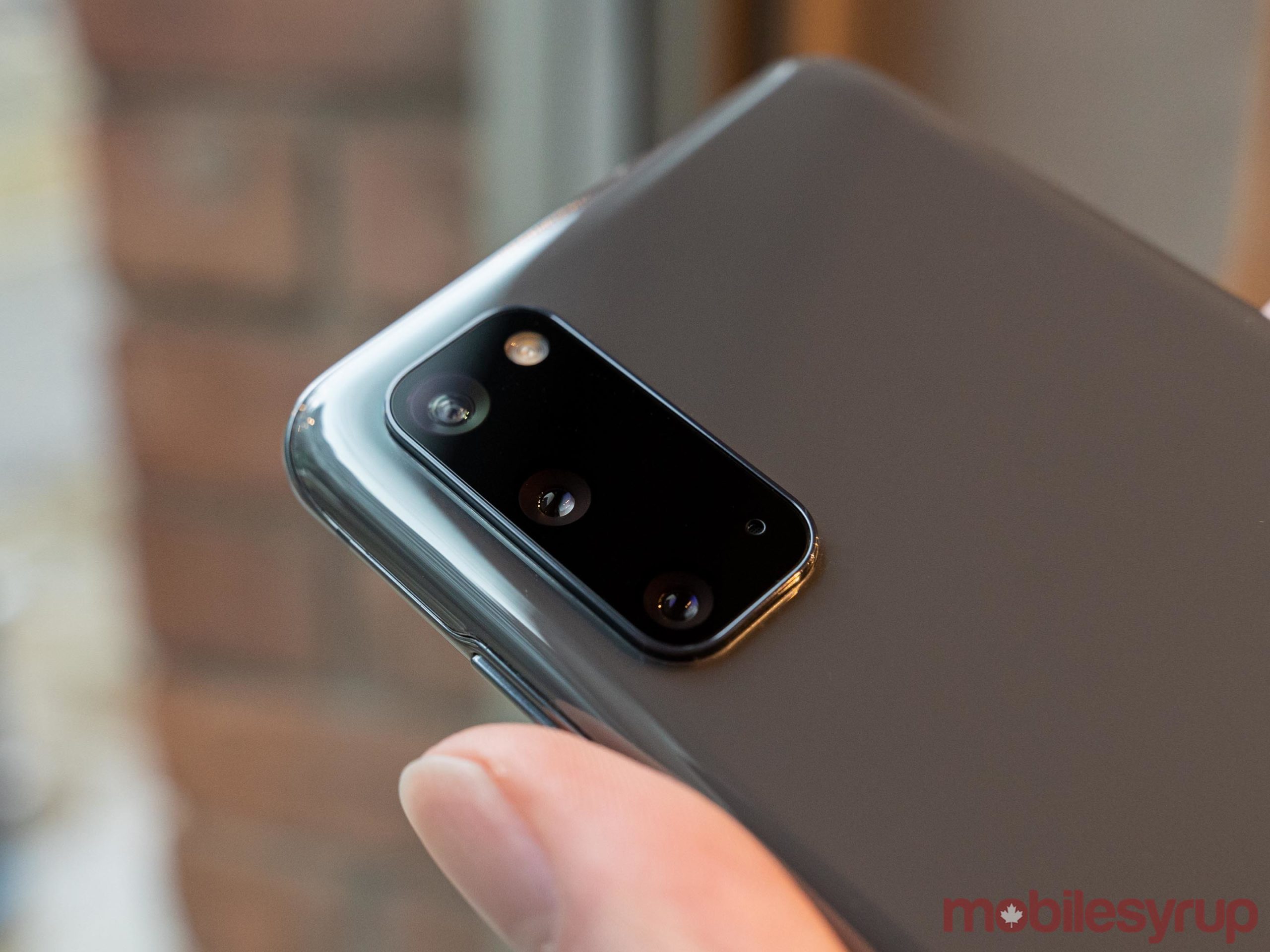
The S20 boasts the same Samsung design you’re familiar with while changing it up in small ways. Since 2017’s Galaxy S8, Samsung’s phones have sported a relatively similar design; glass front and back panels with an aluminum band around the edge to hold it all together.
That design has shifted in subtle ways since the S8, with bezels shrinking, buttons moving and the camera morphing. The camera in particular has changed significantly on the S20, moving from a centred horizontal line to a long rectangle in the top-left corner of the device. While opinions differ on the camera position and the size of the bump, I find the S20’s to be the least egregious of the three S20 models — and yes, it does look much better in person than in photos.
The other significant change here is the new placement for the power and volume buttons. From the S8 to the S10, Samsung placed the power button on the right side of the phone, volume and Bixby keys on the left. With the S20, the volume rocker and new ‘Side key’ are both on the right-hand side, matching up with the general industry trend but frustratingly avoiding it by putting the volume rocker above the power button. The placement is also an annoying deviation from the Note 10, which had both buttons on the left side.
The Side key is essentially a power button that, by default, triggers Bixby when you hold it down. You can restore the normal behaviour in settings so the button can turn off the S20 by holding down the button instead.
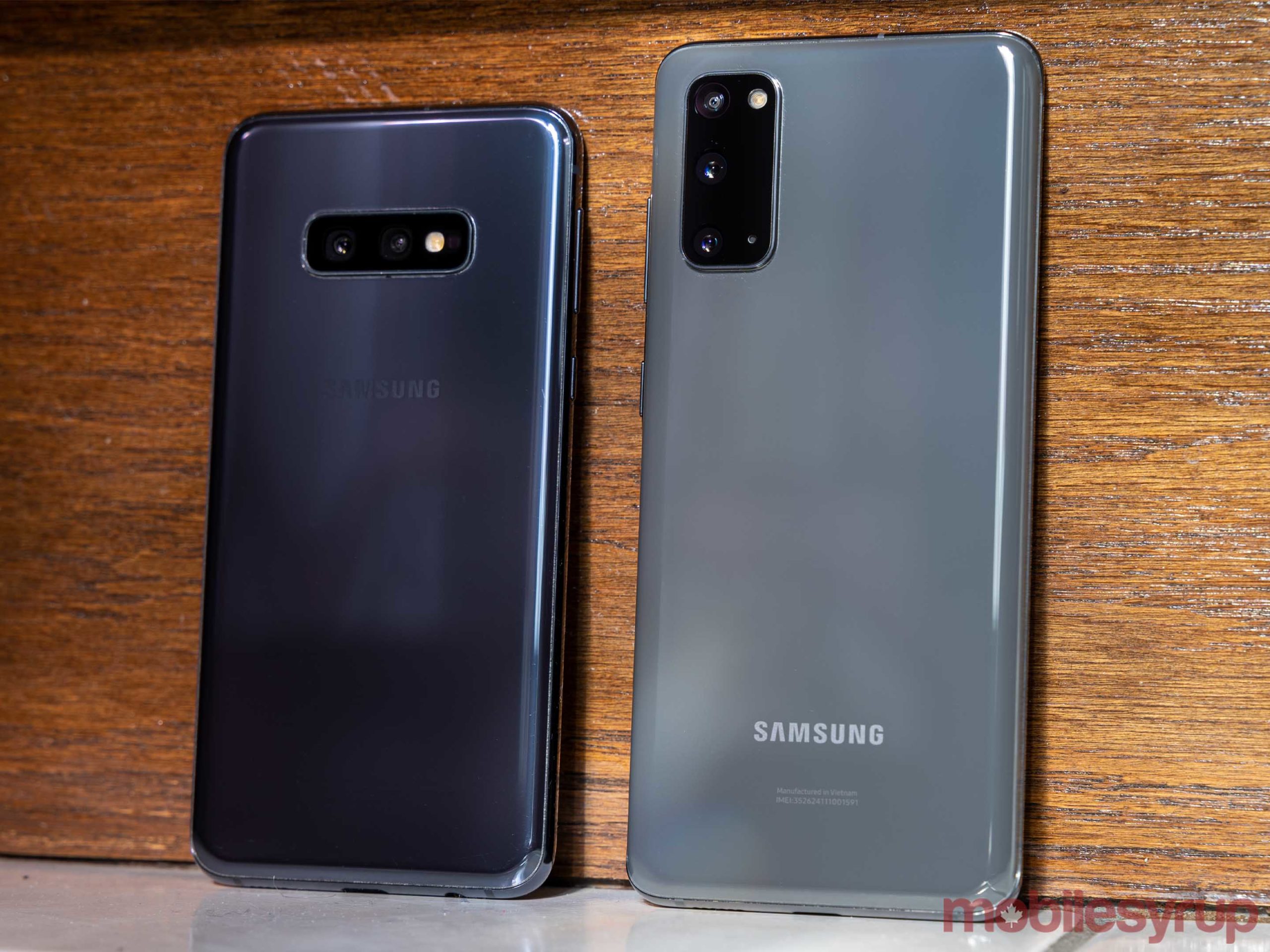
Left: Galaxy S10e. Right: Galaxy S20.
Despite the S20’s large 6.2-inch display, it’s quite handleable. The phone is narrow, which makes it comfortable to hold. One of the biggest issues, however, is the height. It can make pulling down the notification shade tricky with one-handed use. Thankfully, Samsung included software tools to mitigate this, either with ‘One-handed mode’ or with a home screen gesture that lets you swipe down from anywhere to open the notification shade.
What impresses me most about the design of the S20 is it manages to fit a much larger display into a phone only slightly taller than the Pixel 4, which has a smaller 5.7-inch screen. I’ve always preferred having a smaller phone, but not a smaller display. Samsung has managed to fit a massive screen in a compact package.
Samsung also decided to move away from curved screen edges, something we should all celebrate. I know some people like the curved edges, but that smartphone trend has consistently been one of the worst. Samsung dialled back the curved edges significantly in the S20. The screen still curves, but it’s much more subtle and results in far fewer accidental touches than before.
Turn on 120Hz. Just do it.
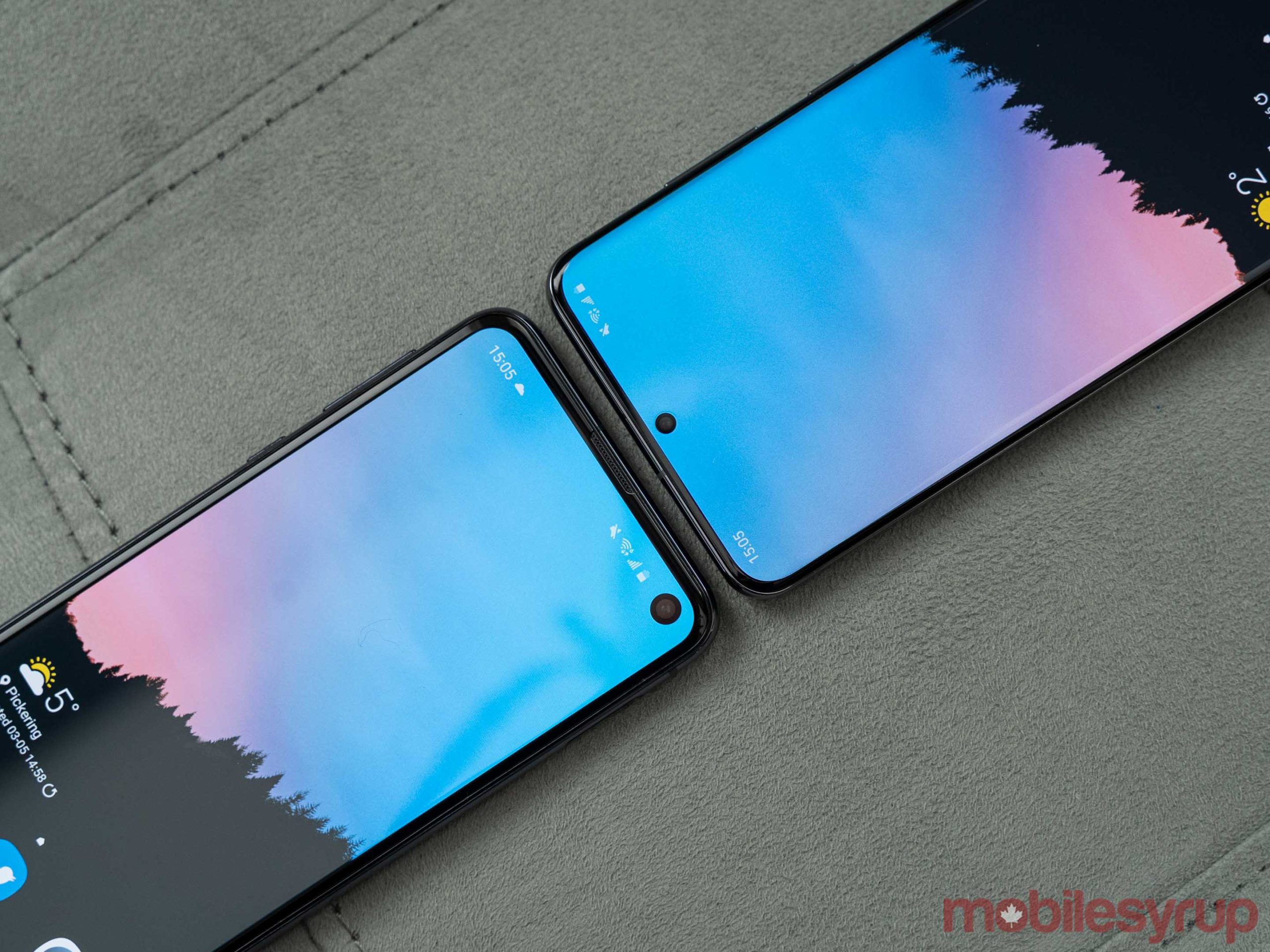
Left: Galaxy S10e selfie camera. Right: Galaxy S20 selfie camera.
Speaking of the display, the S20’s screen is absolutely fantastic. It should come as no surprise at this point — Samsung’s phones consistently have incredible AMOLED panels. The S20 is no different here, offering bright, vibrant colours and deep blacks. However, the excellence is hard to notice without comparing the screen side-by-side with other phones. Sitting the S20 next to a Pixel 4 or even last year’s S10e, you can see how much deeper the blacks are and how vibrant the colours are.
Another notable addition with the S20 line is the centre hole-punch in the display. While it looks good, I think I liked the S10e’s corner hole-punch more. Plus, I found the centre hole-punch camera didn’t always play nicely with apps. It’s more of a nitpick than anything, but apps that include search bars at the top — namely, Google apps — felt crowded.
However, the most significant change with the new display is the addition of a 120Hz refresh rate. Honestly, it’s great. Turn it on. Leave it on. Enjoy it.
Sure, using 120Hz means you can’t use the higher WQHD+ screen resolution, but it’s worth it — trust me.
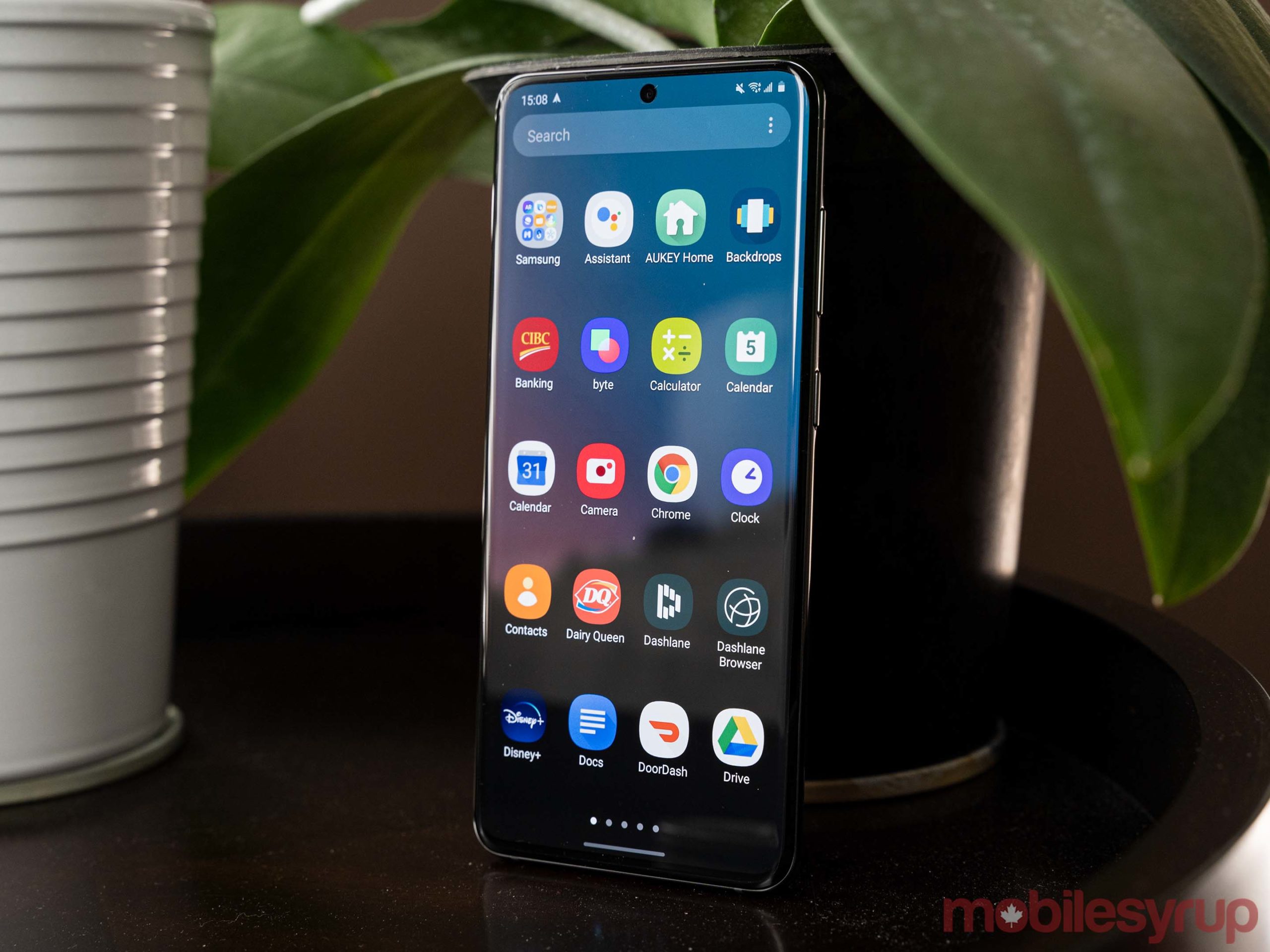
Unless you carefully examine the text on your screen, it’ll be much harder to notice the difference between the S20’s FHD+ and WQHD+ resolutions than to notice a difference between 60Hz and 120Hz.
Everything feels so much more responsive and smooth with the higher refresh rate. There is a hit on battery life, but I found it to be well worth it for improving the feeling of everything you do on the phone.
It’s also worth noting the S20 has 120Hz touch sample rate as well, which means the screen checks for touch input roughly 120 times per second. Ultimately, this allows the phone to detect user input and respond to it faster than a 60Hz touch sample rate, which helps make things more responsive. The S20 uses 120Hz touch sampling regardless if users pick the 60Hz or 120Hz refresh rate. However, the phone automatically increases to a 240Hz touch sample rate when gaming, which should make controls feel much more responsive.
It’s worth noting that the S20 will automatically scale down to 60Hz in some apps, either because of performance issues or other limitations within the app. Further, it may automatically switch to 60Hz in certain conditions, such as under high temperatures or when the battery is low. In practice, I never noticed the phone do this and generally all the apps I tried worked fine with 120Hz with the exception of Google Maps and the camera app, which default to 60Hz regardless of the settings.
A competent camera

Camera performance is arguably the most critical aspect of a smartphone these days, especially in a flagship like the S20. Samsung has also done itself no favours by making the camera central to the marketing of the phone.
While the S20 may not have as many cameras or as high-tech features as the S20+ or Ultra, it certainly has some respectable chops and, in short, will be an excellent shooter for most people. Does that make it the best camera out there? No, not really.
Notice the bloom around the edges of the pillar in the S20 photo caused by HDR.
Put it this way: for the average user, the Samsung S20 camera is excellent. It’s more than good enough for everything you’ll use it for. In small ways, I think that the Pixel 4 or the iPhone 11 Pro best the S20, but on the whole, you won’t be disappointed with the phone’s images. Plus, I’d argue it’ll work better for most people than the S20 Ultra, which MobileSyrup managing editor Patrick O’Rourke notes has problems with autofocus, especially in low-light. The S20 didn’t encounter any of these issues.

Galaxy S20 Live Focus shot
Pictures I took were consistently sharp, with vibrant colours and superb contrast. Further, Samsung’s Live Focus mode is much improved, with it handling hair and fur much better than I’ve seen it before.
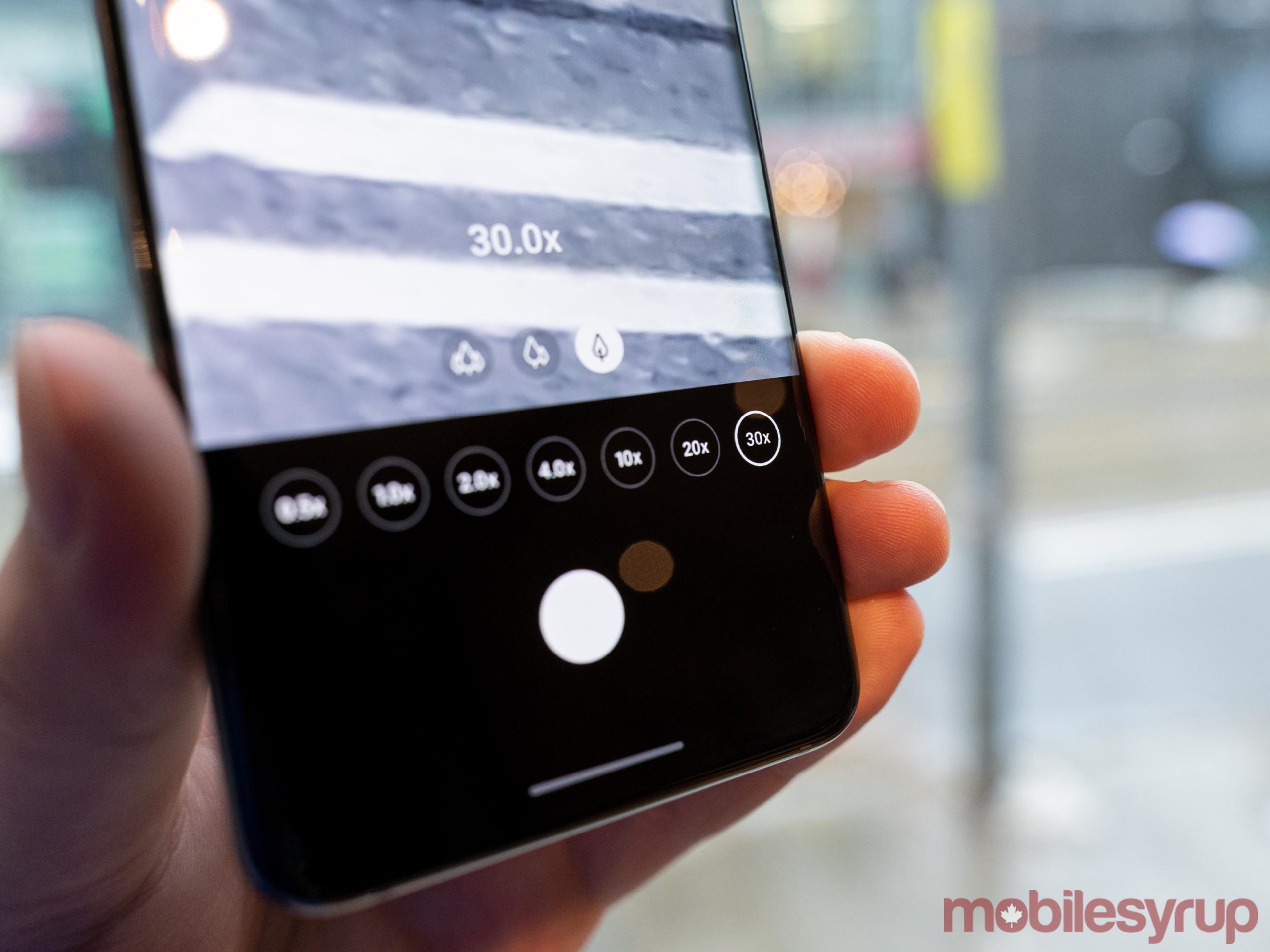
The S20 also boasts a ridiculous 30x zoom feature thanks in part to its 64-megapixel zoom camera. However, if you actually want to take pictures with the higher resolution, you need to toggle it on in the camera’s settings. By default, it captures 12-megapixel telephoto images and, to be frank, I thought it worked fine. In general, the quality was close to, but usually not quite as good as the Pixel 4 at similar zooms. While the S20 can zoom in much closer, the greater the magnification, the less clear the image is, especially if you don’t brace the phone against something.
Better lighting seemed to help improve the zoom functionality, but it wasn’t meaningful enough that I’d recommend shooting at 30x. I found it performed best at around 5x to 10x zoom.
Samsung’s Single Take feature is a nice addition as well — it records for a few seconds and captures pictures and video of the subject with the phone’s multiple cameras and then presents you with a few clips, images and stylized pictures. While fun, I found it didn’t reliably capture the moments I wanted. For example, using Single Take on my fiance while she skipped stones resulted in pictures of her before and after the throw, but not at the moment of the toss.
Single Take could be useful for capturing clips and stills of action, such as someone playing sports, but I’m not sure it’s reliable enough to use in a situation like that.
As for video, the S20 performed quite well. If you’re looking to film video with a smartphone, this is probably the one to do it with — just leave 8K turned off. At this point, 8K recording is little more than a gimmick. There’s just not really anything you can do with the footage yet and far too many other limitations. In my testing, I found the 4K 60fps footage produced by the S20 to be consistently much better thanks to autofocus, stabilization and the higher frame rates producing smoother video overall.
While I’m not much of a selfie taker, the S20 seemed to produce solid pictures with its front-facing camera. The S20 Ultra does perform much better in this regard, but overall I found the S20 was acceptable. I also didn’t notice as much over-exposing or skin smoothing as noted by others. Ultimately, if you really care about selfies, check out MobileSyrup staff reporter Dean Daley’s Galaxy S20+ review for a more in-depth look at the selfie cam, as well as other camera features like the ‘Night mode.’
Performance for days
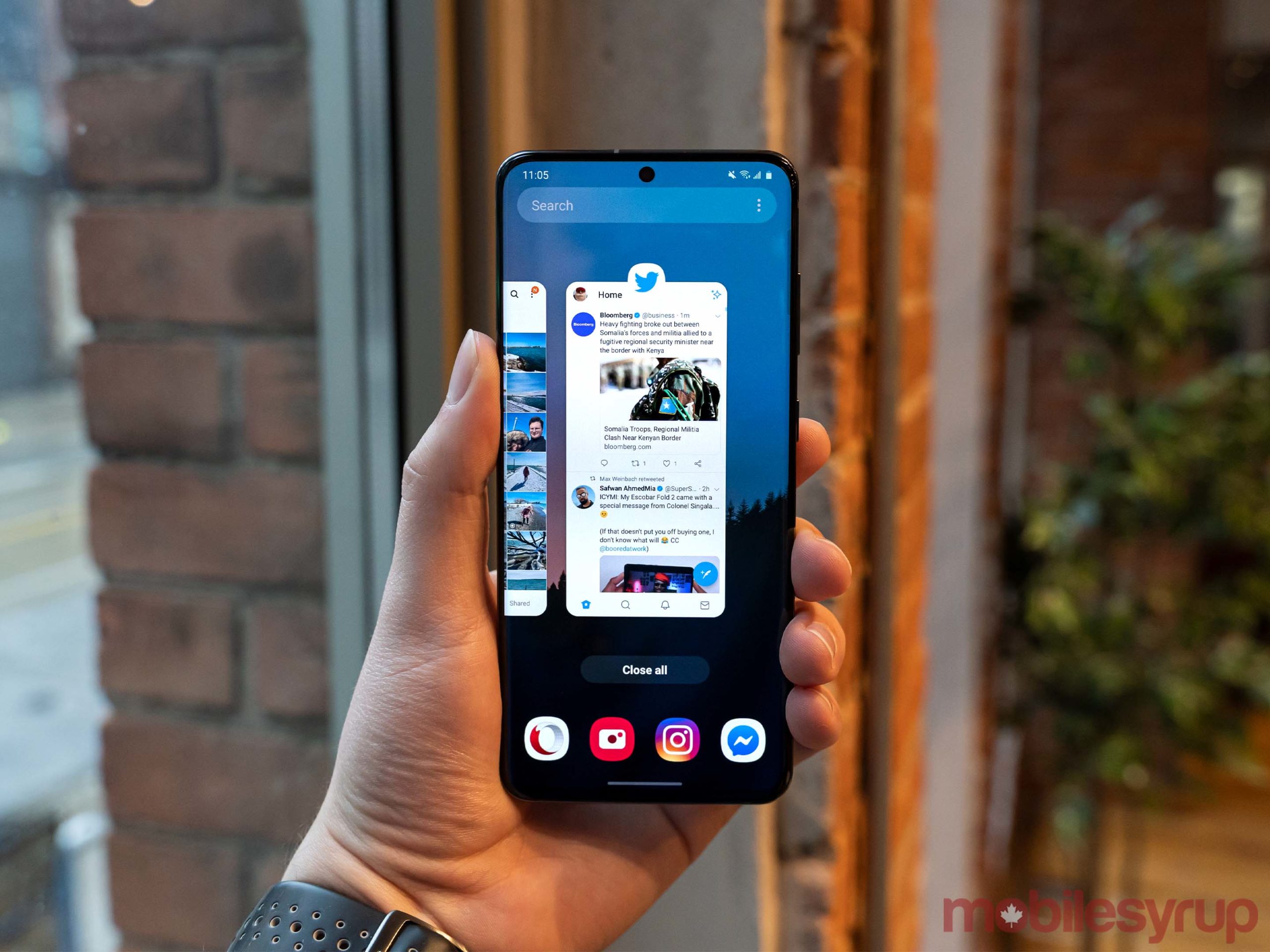
Performance is another critical aspect of smartphones and, thankfully, the S20 is no slouch. As one of the first smartphones to launch with Qualcomm’s Snapdragon 865 chipset, it’s a testament to how powerful this thing is. Coupled with an absurd 12GB of RAM, the S20 absolutely flies.
It seemed that no matter what I threw at it, the S20 kept going. The experience streaming music, videos, gaming, social media and more was smooth and fast.
Plus, the 12GB of RAM let me open up all of the nearly 100 apps on my S20 without any noticeable slowdowns.
However, what’s more impressive than the S20’s performance was battery life. With the 4,000mAh battery in the S20, I found it easily lasted me a day and, depending on how heavy my usage was, sometimes longer. It may not seem like much, but coming from a Pixel 4, it made a world of difference. To compare, it’s quite a bit bigger than both the Pixel 4’s 2,800mAh and the S10e’s 3,100mAh batteries.
In most cases, I made it to the end of a day with about 30 or 40 percent charge remaining and around four or more hours of screen-on time on the ‘Optimized’ setting with 120Hz refresh, FHD+ resolution and auto-brightness turned on. Of course, you could likely do better by using one of the other semi-customizable power modes. ‘Maximum power saving,’ for example, lets you disable 5G connectivity, turn off Always On Display and cap CPU speed to save power. Users can pick any combination of the three as they see fit, as well as decrease brightness and screen resolution for that specific power mode.
Samsung also includes an ‘Adaptive power saving’ setting that automatically switches between the four available power-saving modes, but I didn’t find it necessary.
While some may welcome the wealth of options for customizing phone performance, I found the default ‘Optimized’ setting worked well enough that I didn’t need to tweak these options at all.
In-display fingerprint scanner is hit or miss

However, despite the excellent overall performance, I encountered a few odd stutters and other animation jank that just made the whole experience feel lower quality.
This was most apparent with the animation that plays when scanning your fingerprint with the S20’s ultrasonic in-display fingerprint reader. That animation often lost frames or locked up in weird ways. Other animations would sometimes stutter and drop frames, but none were as consistently problematic as the fingerprint scanner.
Speaking of which, I found it to be generally slow and unreliable. When I first set it up, it seldom recognized my finger. After re-adding my fingerprint, it got much better but still wasn’t perfect. I found the scanner had roughly a 70 percent success rate and, in most cases, using the face unlock was much faster. To be fair, the more I used the S20, the better the fingerprint reader got, but it was never a great experience.
Neither the S20+ or Ultra review units we received had similar issues, so something may be wrong with the S20 I tested.
One UI could benefit from simplification
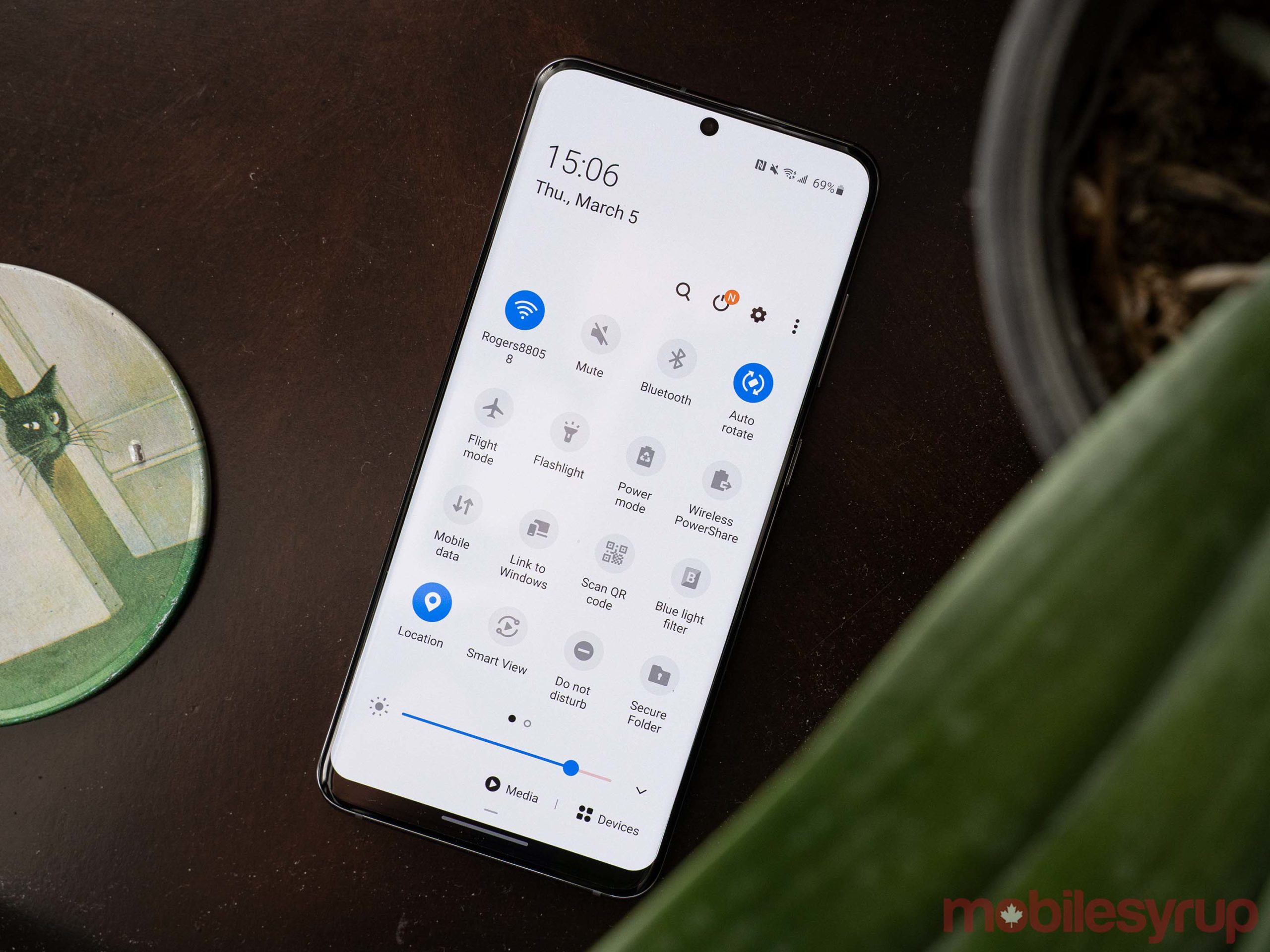
One UI is the best thing to ever happen to Samsung phones.
I thoroughly love the interface, and I think it’s better than the stock-like flavour of Android that ships on Pixel phones in many ways.
However, despite all the good, One UI also has some serious flaws. First and foremost is the bloat. This isn’t just extra pre-installed apps — although you’ll still find a bunch of those on your S20 and they are a frustrating experience to say the least.
Samsung’s whole mentality with One UI is to provide as many options to users as possible. Things like the quick settings page or the camera app are overloaded with settings and it can be incredibly overwhelming, even for someone like me who spends all their time with tech.
One UI could benefit from slimming down on the options. Keep them around for the power users who want to tweak every setting, but tuck them away for the average user.
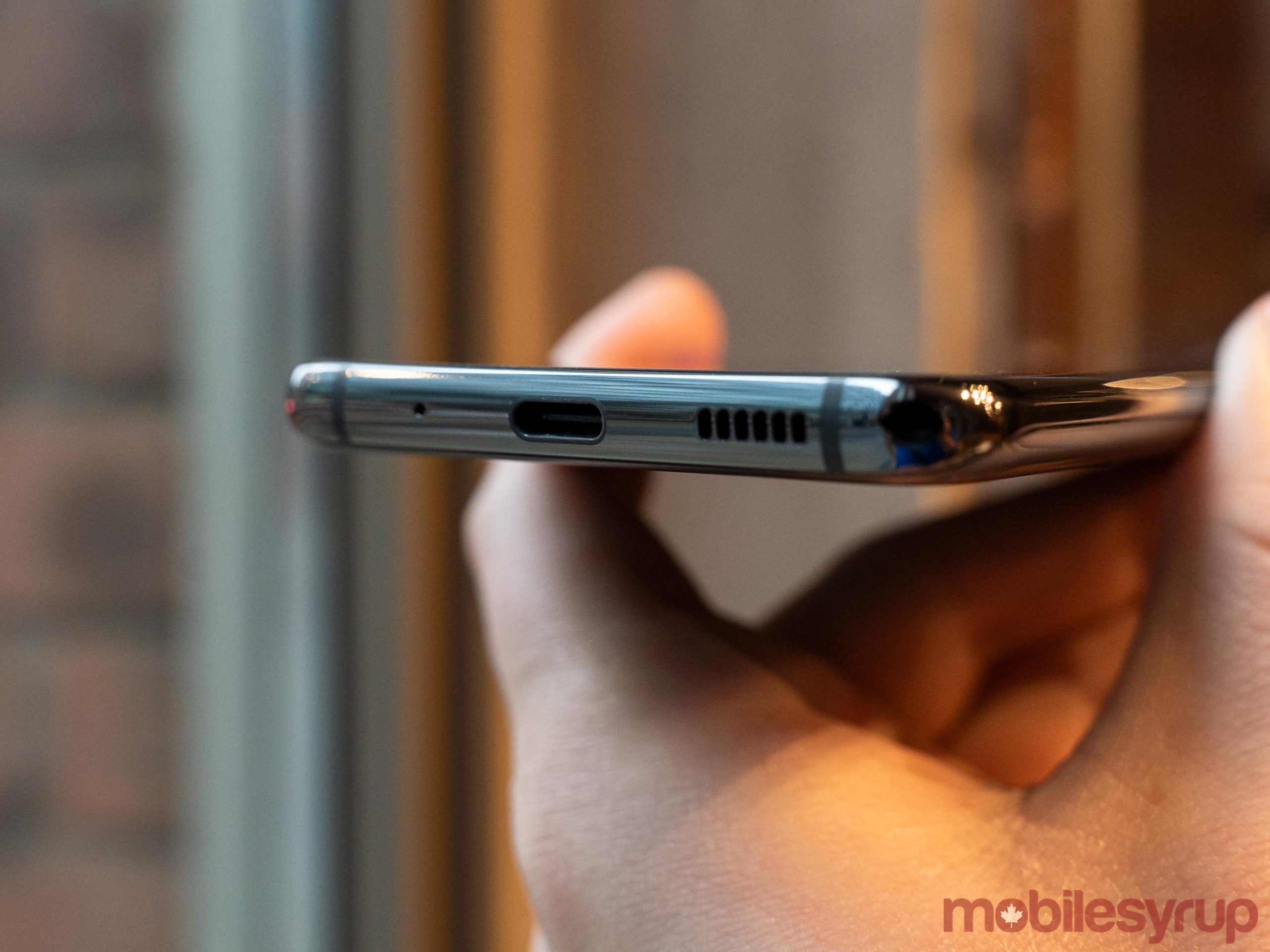
Another frustration with Samsung’s One UI is the emoji selection. While personal preference may have much to do with this, I find the current emoji design on One UI to look nothing like emoji on any other device, Android or otherwise. Unfortunately, there’s no way around this without rooting your phone, although some apps do thankfully let you use different emoji within them. On the whole, this is one area Samsung would do well to improve.
Finally, one big One UI tweak that accompanied the S20 is Google Duo integration. Samsung’s Phone, Contacts and Messages apps all include a shortcut to start a Duo call with someone. It’s a welcome change that should help synonymize Duo with video calls on Android.
The things I couldn’t test
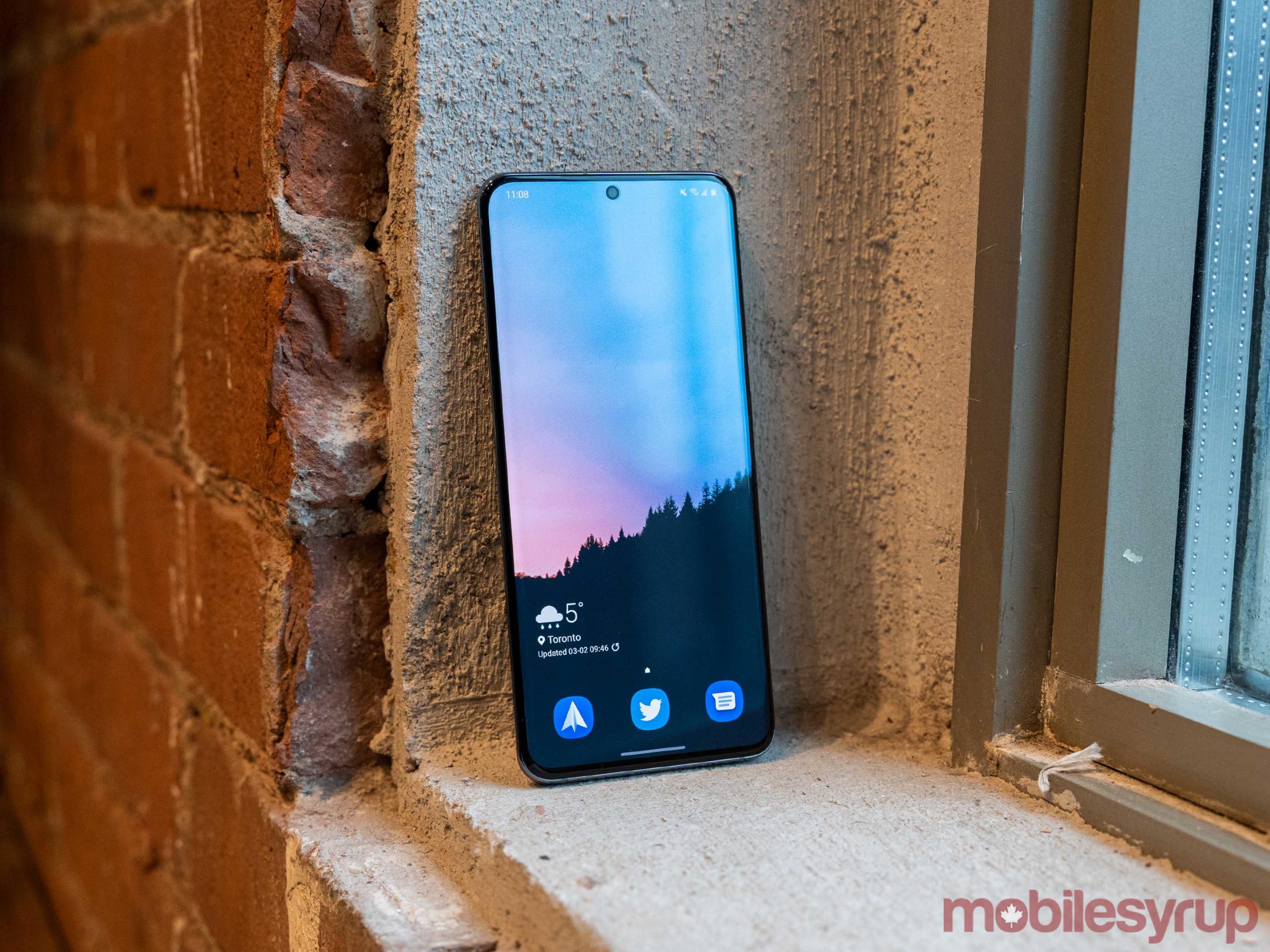
Unfortunately, there’s so much packed into the Galaxy S20 that there’s plenty I also couldn’t test.
The biggest of those is 5G, which is also Canadian telecom’s elephant in the room. Rogers went live with its 5G network on March 6th alongside the S20’s release. However, the network is limited to downtown Vancouver, Toronto, Ottawa and Montreal. Further, MobileSyrup wasn’t able to test this network, so we can’t speak to the benefits it provides, if any.
Despite the hyper-limited nature of 5G in Canada, all the Samsung S20 phones sold here sport 5G branding, which is bound to confuse some people.
Practically, this means the S20 — and most flagships this year with Snapdragon’s X55 modem — will be ‘5G ready,’ so when Canada’s 5G networks go online and expand, chances are most 2020 phones will already support them.
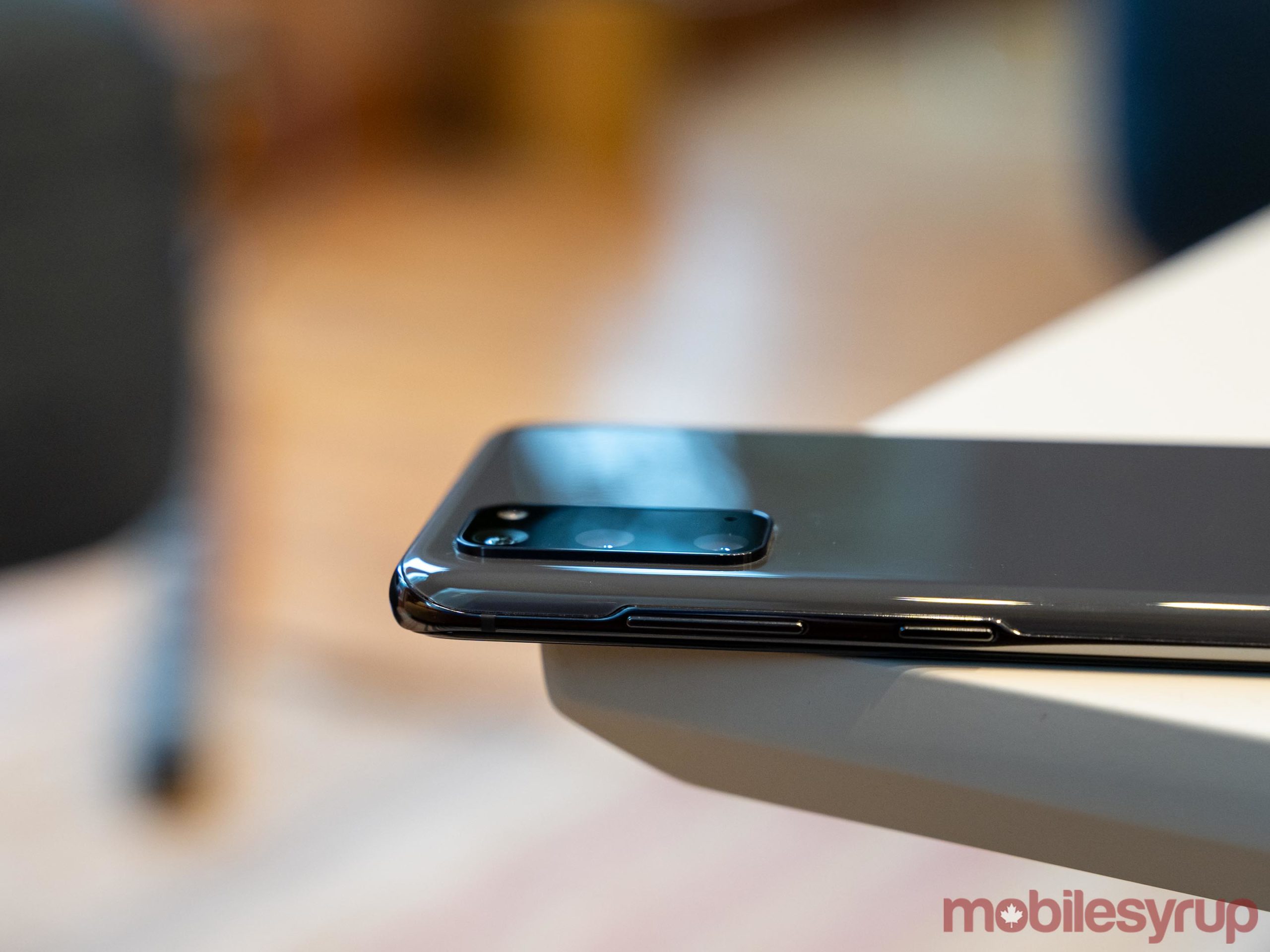
It also means if you’re thinking of upgrading to the S20 for 5G, it’s probably not worth your time yet. Wait until the networks expand if you can.
I was also unable to test the 45W fast charging feature Samsung added to the S20 phones since MobileSyrup didn’t receive any of the necessary accessories to do that.
It's a lot of phone for a lot of money
Suffice it to say that Samsung's Galaxy S20 is an excellent phone.
Samsung's phones continue to be among the best in the Android world, and it's easy to see why. With an incredible display, impressive specs and a solid camera, the S20 gets just about everything right.
And yet, for all the raw power, the S20 lacks in some important areas. As good as the cameras are, other phones get better results. Further, as someone who used the Pixel 4 as a daily driver before testing the S20, I found the Pixel felt smarter and more responsive to me. Sure, the S20 outperformed it, but performance isn't everything.
That said, many of the shortcomings I addressed are more nitpicks or personal frustrations than anything inherently wrong with the device.
As such, I'd say that the S20 is well worth your time and your money, even at it's eye-watering $1,319.99 price. While it’s a definite price jump across the lineup, for what you get in the S20, I think it’s well worth the cost. In fact, the S20 is so good that I felt no desire to move up to the S20+ or Ultra for things like improved cameras or bigger displays.
The S20 is excellent, but I believe it's peak smartphone. It's so good that the bigger, arguably better S20+ and Ultra fail to justify themselves.
Unfortunately, I also think the S20 is far from realizing its full potential, at least in Canada. Without 5G, the S20 alone may not do enough to justify the upgrade or the price.
The Galaxy S20 is available in 'Cosmic Grey' and 'Cloud Blue' with 128GB of storage and 12GB of RAM for $1,319 CAD
Update 03/06/2020 at 9:43am: Updated the article to better reflect the current state of 5G in Canada following Rogers' limited launch of 5G.
"The Galaxy S20 is so good, the bigger and better S20+ and Ultra fail to justify themselves"
MobileSyrup may earn a commission from purchases made via our links, which helps fund the journalism we provide free on our website. These links do not influence our editorial content. Support us here.

